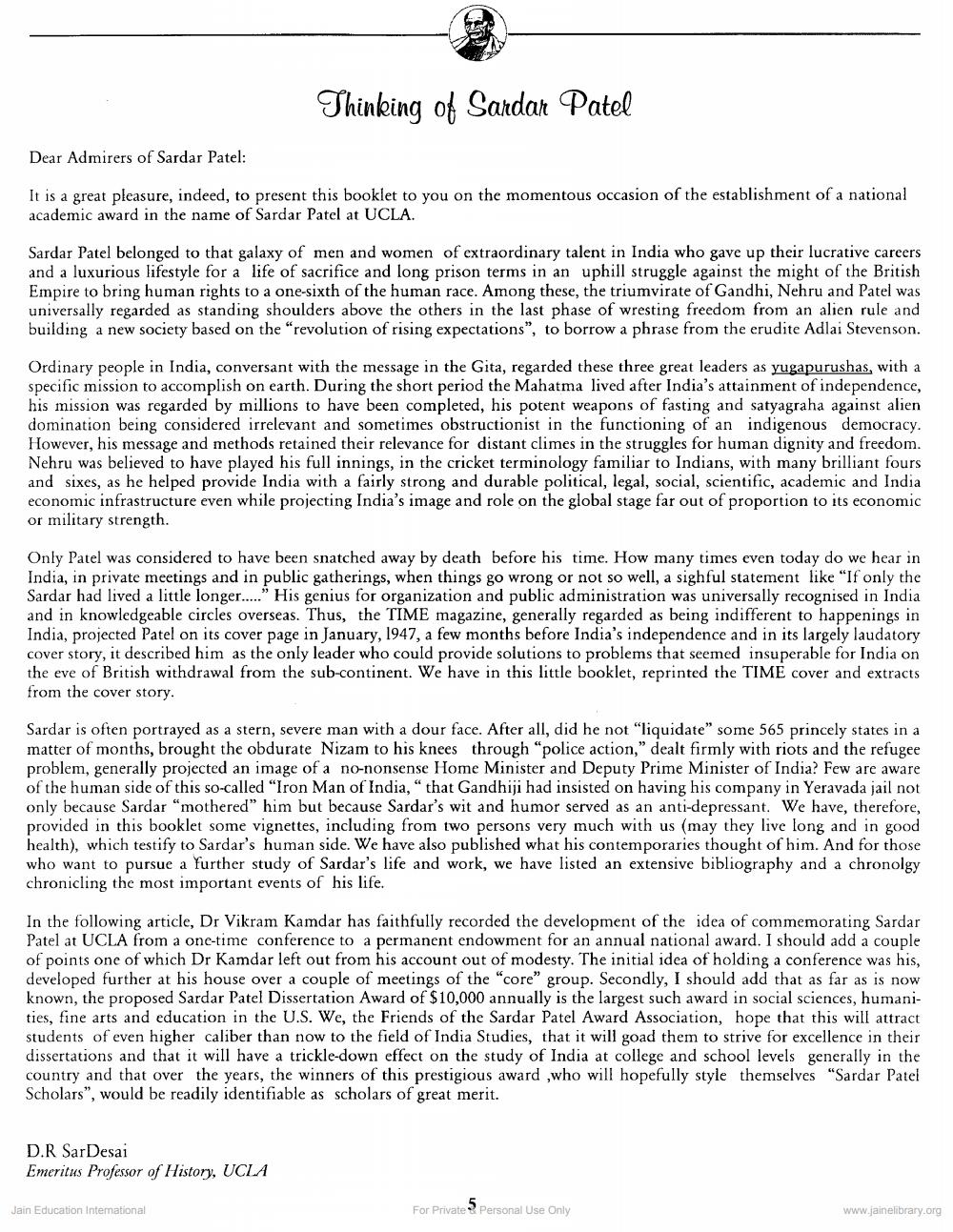________________
Thinking of Sardar Patel
Dear Admirers of Sardar Patel:
It is a great pleasure, indeed, to present this booklet to you on the momentous occasion of the establishment of a national academic award in the name of Sardar Patel at UCLA.
Sardar Patel belonged to that galaxy of men and women of extraordinary talent in India who gave up their lucrative careers and a luxurious lifestyle for a life of sacrifice and long prison terms in an uphill struggle against the might of the British Empire to bring human rights to a one-sixth of the human race. Among these, the triumvirate of Gandhi, Nehru and Patel was universally regarded as standing shoulders above the others in the last phase of wresting freedom from an alien rule and building a new society based on the “revolution of rising expectations", to borrow a phrase from the erudite Adlai Stevenson.
Ordinary people in India, conversant with the message in the Gita, regarded these three great leaders as yugapurushas, with a specific mission to accomplish on earth. During the short period the Mahatma lived after India's attainment of independence, his mission was regarded by millions to have been completed, his potent weapons of fasting and satyagraha against alien domination being considered irrelevant and sometimes obstructionist in the functioning of an indigenous democracy. However, his message and methods retained their relevance for distant climes in the struggles for human dignity and freedom. Nehru was believed to have played his full innings, in the cricket terminology familiar to Indians, with many brilliant fours and sixes, as he helped provide India with a fairly strong and durable political, legal, social, scientific, academic and India economic infrastructure even while projecting India's image and role on the global stage far out of proportion to its economic or military strength.
Only Patel was considered to have been snatched away by death before his time. How many times even today do we hear in India, in private meetings and in public gatherings, when things go wrong or not so well, a sighful statement like “If only the Sardar had lived a little longer....." His genius for organization and public administration was universally recognised in India and in knowledgeable circles overseas. Thus, the TIME magazine, generally regarded as being indifferent to happenings in India, projected Patel on its cover page in January, 1947, a few months before India's independence and in its largely laudatory cover story, it described him as the only leader who could provide solutions to problems that seemed insuperable for India on the eve of British withdrawal from the sub-continent. We have in this little booklet, reprinted the TIME cover and extracts from the cover story.
Sardar is often portrayed as a stern, severe man with a dour face. After all, did he not "liquidate" some 565 princely states in a matter of months, brought the obdurate Nizam to his knees through "police action," dealt firmly with riots and the refugee problem, generally projected an image of a no-nonsense Home Minister and Deputy Prime Minister of India? Few are aware of the human side of this so-called “Iron Man of India," that Gandhiji had insisted on having his company in Yeravada jail not only because Sardar "mothered" him but because Sardar's wit and humor served as an anti-depressant. We have, therefore, provided in this booklet some vignettes, including from two persons very much with us (may they live long and in good health), which testify to Sardar's human side. We have also published what his contemporaries thought of him. And for those who want to pursue a further study of Sardar's life and work, we have listed an extensive bibliography and a chronolgy chronicling the most important events of his life.
In the following article, Dr Vikram Kamdar has faithfully recorded the development of the idea of commemorating Sardar Patel at UCLA from a one-time conference to a permanent endowment for an annual national award. I should add a couple of points one of which Dr Kamdar left out from his account out of modesty. The initial idea of holding a conference was his, developed further at his house over a couple of meetings of the "core" group. Secondly, I should add that as far as is now known, the proposed Sardar Patel Dissertation Award of $10,000 annually is the largest such award in social sciences, humanities, fine arts and education in the U.S. We, the Friends of the Sardar Patel Award Association, hope that this will attract students of even higher caliber than now to the field of India Studies, that it will goad them to strive for excellence in their dissertations and that it will have a trickle-down effect on the study of India at college and school levels generally in the country and that over the years, the winners of this prestigious award ,who will hopefully style themselves "Sardar Patel Scholars", would be readily identifiable as scholars of great merit.
D.R SarDesai Emeritus Professor of History, UCLA
Jain Education Intemational
For Private Personal Use Only
www.jainelibrary.org




